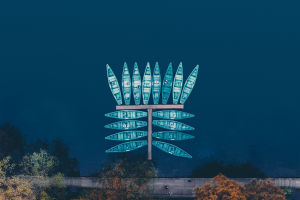Blue Gemstone On The Earth
There’s just something about clear water that captivates us with its serenity and pristine beauty. Many lakes are brown and murky, but some are so clear that rocks and logs can be visualized below the sparkling surface, and the bottom may seem to be so close.
Fish may also be spotted swimming along—but actually, clear lakes might not have as many fish in them as the brown kind. Murky water tends to have more organic material and algae, which fish eat, and so can support more aquatic creatures.
But, a brightly colored lake might also have certain types of algae that give it its amazing hue. Let’s take a look at some clear lakes that seem too gorgeous to be real. But thanks to the wonders of nature.
1.Lake Blausee, Switzerland
Mountainous Switzerland is another country known for its abundance of crystal blue lakes, including Lucerne, Brienz, and Oeschinen. Fed by underground springs, the lake is completely transparent, with a lovely blue-green color.
Sunken tree trunks and boulders are visible all the way down to the bottom 40 feet below. This is another lake seeped in legend: According to the tale, a broken-hearted, blue-eyed maiden drowned in the lake, and her tears turned the water its azure hue. Switzerland also has one of the 9 heart-shaped lakes and islands around the world.
2.Moraine Lake, Canada
Canada is renowned for its lovely lakes, as the country’s alpine locales lend themselves to the creation of crystal-clear mountain waters. Lake Louise in Banff National Park in the province of Alberta is perhaps the most popular, and it’s clearly gorgeous.
But our pick is the nearby Moraine Lake, a glacial-fed body of water with a transparent blue hue nestled in the Valley of the Ten Peaks. The color changes depending on where the lake is viewed from, the time of day, and even the time of year—summer provides the brightest hue.
The lake is so stunning it was even featured on the Canadian $20 bill in the 1970s. These are more of the most popular destinations in Canada.
3.Blue Lake, New Zealand
You can’t swim in this protected lake in New Zealand, but you can hike through the Travers-Sabine Circuit track in Nelson Lakes National Park to see it.
A sacred place for the Ngati Apa, a local Maori tribe, this lake is considered the clearest in the world, with a visibility of 76 meters, compared with 80 meters for distilled water, according to The Guardian.
Water from a pristine upper lake filters through glacial debris before flowing into Blue Lake, resulting in its remarkable clarity. Even more fascinating, all of the lake water is naturally replaced almost daily.
4.Rio Sucuri, Brazil
Less than 15 miles from Bonito, Brazil, you’ll find the transparent waters of Rio Sucuri. The Amazon might be more famous, but this freshwater river springs from artesian wells, making its entire length crystal clear.
It can take about an hour to float or snorkel your way down the river while viewing tropical fish and lush subaquatic gardens along the way. (Boat trips are a good option for families with small children.) Look out for groups of monkeys along the shoreline.
5.Lampedusa, Sicily, Italy
Lampedusa is the largest and most stunning of the Italian Pelagie islands in the Mediterranean Sea, and so far south that it’s actually closer to Tunisia than mainland Italy. All of those are very valid reasons to pay a visit.
But what you’re really here for is that famous water: shimmering, crystalline, and electric-blue. Rabbit Beach is the island’s most popular swimming spot, offering blissful shallows to splash around in, framed by gently sloping limestone cliffs.
6.Maldives
A roundup of the world’s bluest waters would be incomplete without the Maldives, home of turquoise-blue waters so vibrant they seem surreal. In fact, Maldivian waters are so translucent, it often appears as if the boats sailing around the islands are floating in mid-air.
As as if the water weren’t already luminous enough, travelers on the Maldivian island of Vaadhoo have recently been witnessing water that literally glows blue as a result of a chemical reaction called bioluminescence—allowing you to marvel its beauty, even in the dark.


